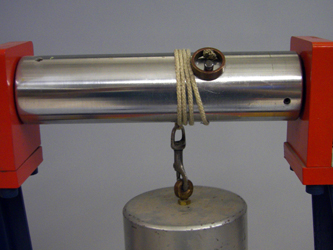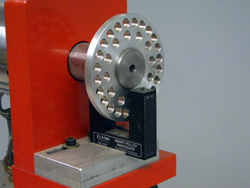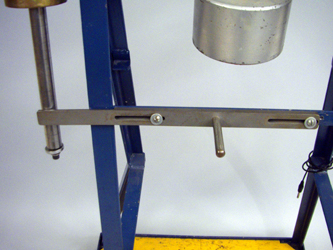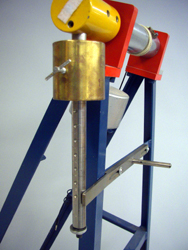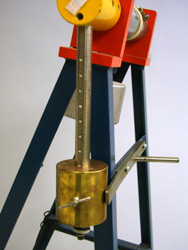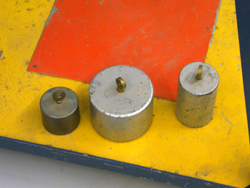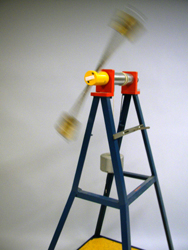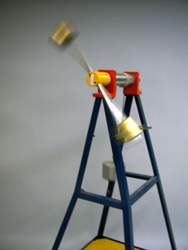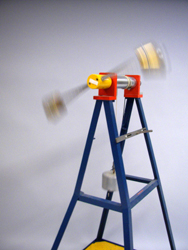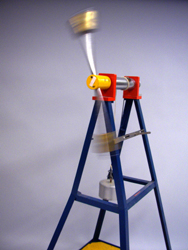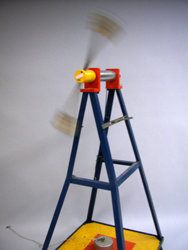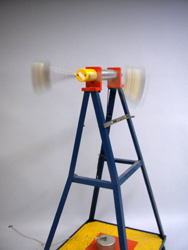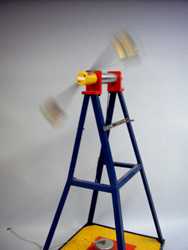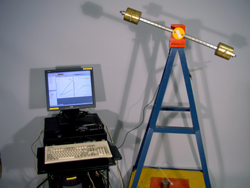|
Size: 6215
Comment:
|
Size: 6822
Comment: converted to 1.6 markup
|
| Deletions are marked like this. | Additions are marked like this. |
| Line 2: | Line 2: |
| ||<:30%>[:PiraScheme#Mechanics: Table of Mechanics Demonstration]||<:30%>[:MEEquipmentList: List of Mechanics Equipment & Supplies]||<:30%>[:Demonstrations:Lecture Demonstrations]|| | ||<:30%>[[PiraScheme#Mechanics| Table of Mechanics Demonstration]]||<:30%>[[MEEquipmentList| List of Mechanics Equipment & Supplies]]||<:30%>[[Demonstrations|Lecture Demonstrations]]|| |
| Line 7: | Line 7: |
| Rotational Dynamics, [:RotationalDynamics#RotationalEnergy: 1Q20. Rotational Energy] | Rotational Dynamics, [[RotationalDynamics#RotationalEnergy| 1Q20. Rotational Energy]] |
| Line 10: | Line 10: |
| * [:MechanicsCabinet#MEFloorItems: Floor Item: ME, South Wall] | * [[MechanicsCabinet#MEFloorItems| Floor Item: ME, South Wall]] |
| Line 12: | Line 12: |
| attachment:WeightAxleII03-400.jpg | {{attachment:WeightAxleII03-400.jpg}} |
| Line 20: | Line 20: |
| ||Weight and Axel II||[:MechanicsCabinet#MEFloorItems: Floor Item: ME, South Wall]|| || ||[:PASCOInterfaceComputer: PASCO Interface Computer w/photogate]||[:MechanicsCabinet#MEFloorItems: Floor Item: ME, South Wall]|| || |
||Weight and Axel II||[[MechanicsCabinet#MEFloorItems| Floor Item: ME, South Wall]]|| || ||[[PASCOInterfaceComputer| PASCO Interface Computer w/photogate]]||[[MechanicsCabinet#MEFloorItems| Floor Item: ME, South Wall]]|| || |
| Line 26: | Line 26: |
| * '''''The axle spends fast and there is No emergency breaking system on the axle to stop it from rotating.''''' * '''''To stop the axle's quickly, use your flat hand and place it on the horizontal axle like a brake until it stops. Watch out for the the peg on the axle for the weight. |
|
| Line 42: | Line 43: |
| 1. Please refer to the [:PASCOInterfaceComputer:PASCO Interface Computer, A1.EQ.100] page for general operations of the computer. 1. Before booting up the computer, Place the Weight and Axle II cart nearby and plug in the Pasco photogate to the [:PASCOInterfaceComputer: Pasco interface]. ie. Make sure that the Photo-gate 1/4" plug is in Slot "A" of the PASCO Interface box. |
1. Please refer to the [[PASCOInterfaceComputer|PASCO Interface Computer, A1.EQ.100]] page for general operations of the computer. 1. Before booting up the computer, Place the Weight and Axle II cart nearby and plug in the Pasco photogate to the [[PASCOInterfaceComputer| Pasco interface]]. ie. Make sure that the Photo-gate 1/4" plug is in Slot "A" of the PASCO Interface box. |
| Line 47: | Line 48: |
| 1. If the auto stop feature is setup within Data Studio, the program will automatically stop recoding after the set time interval that was setup. If not, then just click "Stop" in Data Studio after the weight leaves the axle. (see plot below for an example or [:PASCOInterfaceComputer:PASCO Interface Computer, A1.EQ.100] page). | 1. If the auto stop feature is setup within Data Studio, the program will automatically stop recoding after the set time interval that was setup. If not, then just click "Stop" in Data Studio after the weight leaves the axle. (see plot below for an example or [[PASCOInterfaceComputer|PASCO Interface Computer, A1.EQ.100]] page). 1. Note that the Gate-wheel, shown in the photos below, for the photogate has a Spoke Arc Length of 0.015m and a spoke Angle Spacing of 36 degrees. |
| Line 49: | Line 51: |
| attachment:WeightAxleII20-250.jpg | {{attachment:WeightAxleII20-250.jpg}} |
| Line 61: | Line 63: |
| Any rotating object has rotational kinetic energy given by | Any rotating object has rotational kinetic energy given by; |
| Line 65: | Line 67: |
| where I is the moment of inertia of the object and ω is the angular speed. The axle has an adjustable moment of inertia. This can be changed by shifting the radial positions of the brass weights. The further away from the axis of rotation these weights are, the larger I will become for the axle. ω is determined, in our case, by the weight that drops from the axle. This is because the rate of angular acceleration is determined by the applied torque being given by | Where I is the moment of inertia of the object and ω is the angular speed. The axle has an adjustable moment of inertia. This can be changed by shifting the radial positions of the brass weights. The further away from the axis of rotation these weights are, the larger I will become for the axle. ω is determined, in our case, by the weight that drops from the axle. This is because the rate of angular acceleration is determined by the applied torque being given by; |
| Line 69: | Line 71: |
| Thus, the greater the mass of the weight, the faster our final angular speed will be. This can be investigated in a more quantitative manner by using the Pasco photogate. The template provided in Data Studio plots angular displacement versus time as well as angular speed versus time. The slope of each plot gives ω(t) and α(t) respectively. Knowing R,,axle,,, the mass of the weight used, the acceleration of gravity, and α, we can extract I and thereby calculate the rotational energy of our system. | Thus, the greater the mass of the weight, the faster our final angular speed will be. This can be investigated in a more quantitative manner by using the PASCO Interface Computer along with the photogate that is mounted on the rear of the alxe. The template provided in Data Studio plots angular displacement versus time as well as angular speed versus time. The slope of each plot gives ω(t) and α(t) respectively. Knowing R,,axle,,, the mass of the weight used, the acceleration of gravity, and α, we can extract I and thereby calculate the rotational energy of our system. |
| Line 72: | Line 74: |
| ||attachment:WeightAxleII04-250.jpg||attachment:WeightAxleII05-250.jpg||attachment:WeightAxleII06-250.jpg||attachment:WeightAxleII07-250.jpg|| ||attachment:WeightAxleII08-250.jpg||attachment:WeightAxleII09-250.jpg||attachment:WeightAxleII10-250.jpg||attachment:WeightAxleII11-250.jpg|| ||attachment:WeightAxleII12-250.jpg||attachment:WeightAxleII13-250.jpg||attachment:WeightAxleII14-250.jpg||attachment:WeightAxleII15-250.jpg|| ||attachment:WeightAxleII16-250.jpg||attachment:WeightAxleII17-250.jpg||attachment:WeightAxleII19-250.jpg||attachment:WeightAxleII20-250.jpg|| |
||{{attachment:WeightAxleII04-250.jpg}}||{{attachment:WeightAxleII05-250.jpg}}||{{attachment:WeightAxleII06-250.jpg}}||{{attachment:WeightAxleII07-250.jpg}}|| ||{{attachment:WeightAxleII08-250.jpg}}||{{attachment:WeightAxleII09-250.jpg}}||{{attachment:WeightAxleII10-250.jpg}}||{{attachment:WeightAxleII11-250.jpg}}|| ||{{attachment:WeightAxleII12-250.jpg}}||{{attachment:WeightAxleII13-250.jpg}}||{{attachment:WeightAxleII14-250.jpg}}||{{attachment:WeightAxleII15-250.jpg}}|| ||{{attachment:WeightAxleII16-250.jpg}}||{{attachment:WeightAxleII17-250.jpg}}||{{attachment:WeightAxleII19-250.jpg}}||{{attachment:WeightAxleII20-250.jpg}}|| |
| Line 78: | Line 80: |
| * [https://www.youtube.com/user/LectureDemostrations/videos?view=1 Lecture Demonstration's Youtube Channel] | * [[https://www.youtube.com/user/LectureDemostrations/videos?view=1|Lecture Demonstration's Youtube Channel]] |
| Line 82: | Line 84: |
| * [https://en.wikipedia.org/wiki/Rotational_energy Wikipedia - Rotational Energy] * [https://en.wikipedia.org/wiki/Torque Wikipedia - Torque] |
* [[https://en.wikipedia.org/wiki/Rotational_energy|Wikipedia - Rotational Energy]] * [[https://en.wikipedia.org/wiki/Torque|Wikipedia - Torque]] |
| Line 86: | Line 88: |
| [:Instructional:Home] | [[Instructional|Home]] |
Weight and Axle II, 1Q20.10
Topic and Concept:
Rotational Dynamics, 1Q20. Rotational Energy
Location:
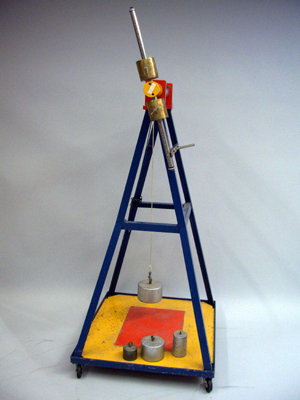
Abstract:
Two equal masses are mounted on a radial bar fixed to a horizontal axle with a pulley. A weight is released which causes it to spin. The masses can be moved in and out. The rotational speed and acceleration of the spinning axle can be monitored with a Pasco photogate.
Equipment |
Location |
ID Number |
|
|
|
Weight and Axel II |
|
|
|
Important Setup Notes:
If using the PASCO interface is desired for the graphical output, a 24-hour notice is required.
The axle spends fast and there is No emergency breaking system on the axle to stop it from rotating.
To stop the axle's quickly, use your flat hand and place it on the horizontal axle like a brake until it stops. Watch out for the the peg on the axle for the weight.
Setup and Procedure: Optional Addition of the PASCO Interface with Computer: Please refer to the PASCO Interface Computer, A1.EQ.100 page for general operations of the computer. Before booting up the computer, Place the Weight and Axle II cart nearby and plug in the Pasco photogate to the Pasco interface. ie. Make sure that the Photo-gate 1/4" plug is in Slot "A" of the PASCO Interface box. If the auto stop feature is setup within Data Studio, the program will automatically stop recoding after the set time interval that was setup. If not, then just click "Stop" in Data Studio after the weight leaves the axle. (see plot below for an example or PASCO Interface Computer, A1.EQ.100 page). Any rotating object has rotational kinetic energy given by; KErot = (1/2)*I*ω2 Where I is the moment of inertia of the object and ω is the angular speed. The axle has an adjustable moment of inertia. This can be changed by shifting the radial positions of the brass weights. The further away from the axis of rotation these weights are, the larger I will become for the axle. ω is determined, in our case, by the weight that drops from the axle. This is because the rate of angular acceleration is determined by the applied torque being given by; α = τnet / I = m*g*Raxle / I Thus, the greater the mass of the weight, the faster our final angular speed will be. This can be investigated in a more quantitative manner by using the PASCO Interface Computer along with the photogate that is mounted on the rear of the alxe. The template provided in Data Studio plots angular displacement versus time as well as angular speed versus time. The slope of each plot gives ω(t) and α(t) respectively. Knowing Raxle, the mass of the weight used, the acceleration of gravity, and α, we can extract I and thereby calculate the rotational energy of our system. 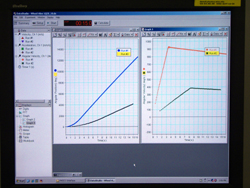
Discussion:
